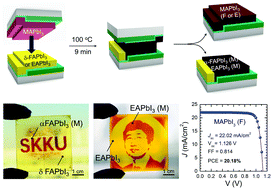当前位置:
X-MOL 学术
›
Energy Environ. Sci.
›
论文详情
Our official English website, www.x-mol.net, welcomes your feedback! (Note: you will need to create a separate account there.)
Bifacial stamping for high efficiency perovskite solar cells†
Energy & Environmental Science ( IF 32.5 ) Pub Date : 2018-11-17 00:00:00 , DOI: 10.1039/c8ee02730g Yong Zhang 1, 2, 3, 4 , Seul-Gi Kim 1, 2, 3, 4 , Donghwa Lee 4, 5, 6, 7 , Hyunjung Shin 2, 3, 4, 8 , Nam-Gyu Park 1, 2, 3, 4
Energy & Environmental Science ( IF 32.5 ) Pub Date : 2018-11-17 00:00:00 , DOI: 10.1039/c8ee02730g Yong Zhang 1, 2, 3, 4 , Seul-Gi Kim 1, 2, 3, 4 , Donghwa Lee 4, 5, 6, 7 , Hyunjung Shin 2, 3, 4, 8 , Nam-Gyu Park 1, 2, 3, 4
Affiliation

|
We report a novel approach for a fast phase transition of FAPbI3 (FA = formamidinium) at low-temperature and the effective removal of interfacial recombination in MAPbI3 (MA = methylammonium). This method also allows for printing (patterning) of the perovskite on a desired area. The pre-annealed MAPbI3 and δ-phase FAPbI3 films were prepared by spin-coating DMSO and a polar aprotic solvent admixed precursor solution at 65 °C and 100 °C for about 1 min, respectively, to form adduct films containing DMSO. Two films were sandwiched without pressure by a method called bifacial stamping, and annealed at 100 °C for 9 min, which resulted in complete δ → α phase transition of FAPbI3 and led to a power conversion efficiency (PCE) of 18.34%. The stamped MAPbI3 demonstrated a PCE of 20.18% that was much higher than the conventionally annealed MAPbI3 (∼17.4%) mainly due to a much higher fill factor and open-circuit voltage. Optical and structural studies revealed that DMSO-mediated ion exchange plays a vital role in the phase transition of FAPbI3 and the surface modification of MAPbI3. Theoretical calculation results further support the role of DMSO in the phase transition at low temperature. Stamping was applied to EAPbI3 (EA = ethylammonium), where photoinactive yellow EAPbI3 changed to photoactive EAPbI3 with a PCE of 13.02% after stamping with MAPbI3. The DMSO-mediated EA/MA ion exchange reaction during the stamping process created a new layer having a gradient solid solution of EAPbI3 and MAPbI3, which was responsible for the abnormally high PCE of the EAPbI3 based perovskite solar cell. Facilitated ion transport by a Lewis base (such as DMSO) reservoir in the perovskite adduct film is suggested to be involved in the bifacial stamping procedure.
中文翻译:

用于高效钙钛矿太阳能电池的双面冲压†
我们报告了一种新颖的方法,用于在低温下快速转变FAPbI 3(FA = Formamidinium ),并有效去除MAPbI 3(MA =甲基铵)中的界面重组。该方法还允许将钙钛矿印刷(图案化)在期望的区域上。通过分别在65°C和100°C下分别旋涂DMSO和极性非质子溶剂混合前驱体溶液约1分钟来制备预退火的MAPbI 3和δ相FAPbI 3膜,以形成包含DMSO的加成膜。通过双面冲压的方法在无压力的情况下将两层膜夹在中间,并在100°C下退火9分钟,从而导致FAPbI 3完全δ→α相变功率转换效率(PCE)为18.34%。冲压后的MAPbI 3的PCE为20.18%,比传统退火的MAPbI 3(〜17.4%)高得多,这主要是由于填充系数和开路电压高得多。光学和结构研究揭示,DMSO介导的离子交换起着FAPbI的相变至关重要的作用3和MAPbI的表面改性3。理论计算结果进一步支持了DMSO在低温相变中的作用。对EAPbI 3(EA =乙基铵)进行压印,其中无光黄色EAPbI 3变为光敏EAPbI 3用MAPbI 3压模后的PCE为13.02%。在冲压过程中,DMSO介导的EA / MA离子交换反应产生了一个新层,该层具有EAPbI 3和MAPbI 3的梯度固溶体,这是基于EAPbI 3的钙钛矿太阳能电池异常高PCE的原因。钙钛矿加合物膜中的路易斯碱(例如DMSO)储层促进的离子迁移被认为参与了双面冲压过程。
更新日期:2018-11-17
中文翻译:

用于高效钙钛矿太阳能电池的双面冲压†
我们报告了一种新颖的方法,用于在低温下快速转变FAPbI 3(FA = Formamidinium ),并有效去除MAPbI 3(MA =甲基铵)中的界面重组。该方法还允许将钙钛矿印刷(图案化)在期望的区域上。通过分别在65°C和100°C下分别旋涂DMSO和极性非质子溶剂混合前驱体溶液约1分钟来制备预退火的MAPbI 3和δ相FAPbI 3膜,以形成包含DMSO的加成膜。通过双面冲压的方法在无压力的情况下将两层膜夹在中间,并在100°C下退火9分钟,从而导致FAPbI 3完全δ→α相变功率转换效率(PCE)为18.34%。冲压后的MAPbI 3的PCE为20.18%,比传统退火的MAPbI 3(〜17.4%)高得多,这主要是由于填充系数和开路电压高得多。光学和结构研究揭示,DMSO介导的离子交换起着FAPbI的相变至关重要的作用3和MAPbI的表面改性3。理论计算结果进一步支持了DMSO在低温相变中的作用。对EAPbI 3(EA =乙基铵)进行压印,其中无光黄色EAPbI 3变为光敏EAPbI 3用MAPbI 3压模后的PCE为13.02%。在冲压过程中,DMSO介导的EA / MA离子交换反应产生了一个新层,该层具有EAPbI 3和MAPbI 3的梯度固溶体,这是基于EAPbI 3的钙钛矿太阳能电池异常高PCE的原因。钙钛矿加合物膜中的路易斯碱(例如DMSO)储层促进的离子迁移被认为参与了双面冲压过程。


























 京公网安备 11010802027423号
京公网安备 11010802027423号